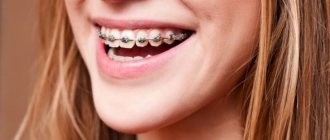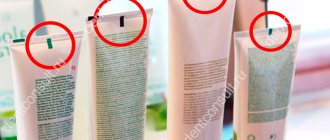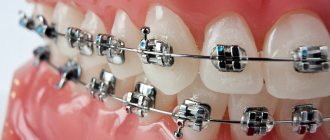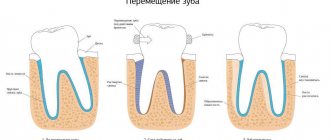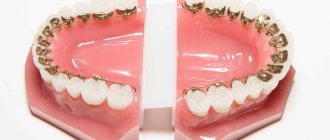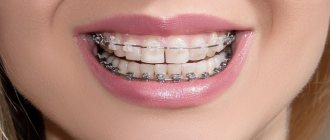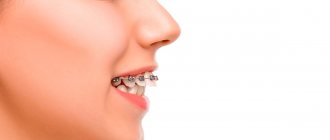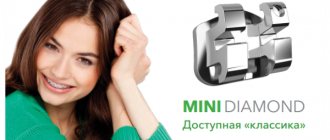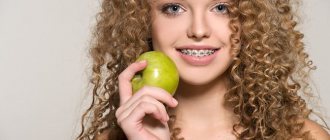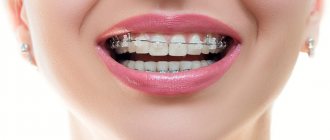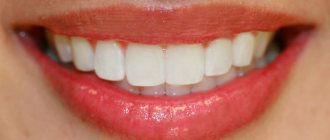The best time to correct your bite with braces is adolescence. But children during puberty are very sensitive to the opinions of others, their self-esteem is often reduced. Metal braces on teeth can become an additional reason for complexes. Multi-colored braces will help solve the problem.
In this article
- What are the design features of colored braces?
- Why do you need colored rubber bands for braces?
- Braces with colored rubber bands - what are they?
- What colors are braces?
- What to consider when choosing the color of braces?
- How are colored braces installed?
- Why is it necessary to replace colored ligatures?
What colored braces look like
In fact, to get a fun color scheme and a variety of shades, doctors use regular classic braces with colored rubber bands, called ligatures. Those. It is not the plates themselves that have a bright tint, but the colored ligatures that act as fixatives for the metal arc in the grooves of the system. In appearance, they resemble rings made of elastic material and can have different diameters and thicknesses. With their help, orthodontists achieve the desired effect of transforming classical systems beyond recognition, creating a bright, individual and unique image that many children and even some adults like so much.
When using self-ligating or non-ligating systems, this effect will no longer be achieved. It is also inappropriate to use ligatures on lingual orthodontic appliances, which are fixed on the inner lingual side of the dentition, because they are invisible to others.
On a note! Currently, the choice of colored braces is very wide and varied. Most often, to give the desired shade, doctors choose rubber bands or ligatures that match the color. However, today some manufacturers produce systems, for example, made of plastic, in which the plate brackets themselves are painted in different colors. Ligatures can have not only different colors, but also various shapes: hearts, diamonds, flowers.
The staples are attached with a special adhesive to the surface of the tooth, from the front side (vestibular). A restoring arch in the form of a wire is pulled through the brackets, and elastic bands serve to prevent movements of the arch in the hole of the bracket. See what braces with colored rubber bands look like in the photo.
Material
The main structure is made from conventional dental materials - metal, ceramics, plastic. The ligatures and rubber bands are colored, and children can also choose picture stickers for the plate itself.
Metal
The preferred material remains metal and metal alloys. Metal devices hold their shape perfectly, do not break, and are convenient for daily use. The unaesthetic appearance of the metal is brightened up by colored rubber bands placed on the staples themselves: the product looks bright and extraordinary. The rubber bands need to be changed once a month at an appointment with the orthodontist. There is no need to come specifically to change the rubber bands: the doctor will replace them during a routine examination and correct the pressure force of the system. The color of the rubber bands is chosen by the patient himself: they can be the same shade or multi-colored.
Plastic
The next material is orthodontic plastic. If earlier plastic products quickly lost their former attractiveness and were painted in the color of the food taken, then in the modern version plastic is created in color. This protects the material from staining food and gives it an elegant look. Even products made of transparent plastic, complemented with bright colored accessories in the form of elastic bands and ligatures, look attractive.
Ceramic
The best material for the manufacture of orthodontic systems, but expensive. Ceramics are always combined with the color of natural tooth enamel; only ligatures in these products can be multi-colored. The same can be said about orthodontic systems made of sapphires: they are decorated with multi-colored rubber bands that disguise the metal arch.
What are ligatures
Ligatures, which can be colored, are designed to secure the arches to the staples. Some people also mistakenly call them elastics or traction bands, but other types of elastic bands have these names. Thus, traction bands or elastics, unlike ligatures, are larger in size and have excellent stretch; they are designed for additional tightening of individual teeth. Also, unlike ligatures, the patient can independently remove them from the mouth at home in order to eat or perform oral hygiene, but ligatures cannot be removed independently - this must be done by the orthodontist.
Color change
Non-standard tones are created using 2 elements: braces and ligatures. Not long ago, multi-colored plastic versions appeared, where not only the ligatures, but also the brackets were painted. The patient can independently choose the shade when ordering the design.
These models are original in form. You can choose a system with brackets in the form of hearts, stars, animals, flowers. These products help you feel free.
Judging by the reviews, the most popular systems remain those with classic braces, where the arches are attached with multi-colored ligatures - elastic bands that are needed for the corrective arch to achieve the desired tension.
Main features and purpose of color systems
Colored braces, as in the photo, differ from ordinary classic ones in that they almost completely cover and disguise the metal arches, and only the locking parts of the system remain open. This feature allows young patients to feel more confident and free from psychological discomfort. Such devices look like a decorative element on the teeth and allow you to create an individual image that will be the envy of other teenagers, which is very important for a child undergoing quite complex orthodontic treatment.
Important! Regardless of what material the braces are made from, they all have a metal arch. The arch itself can also be painted white for aesthetics, but it is important to remember that the top paint may peel off during use due to friction that occurs when the teeth move in a given direction. This factor may slightly increase the treatment time, which is why many patients prefer to leave the metal arch unpainted.
Otherwise, colored braces for children are no different from other models; they have an orthodontic arch that is located above the teeth and moves them in a given direction. They also allow you to correct and correct malocclusions of any complexity.
Not the best color combinations
Of course, there are a great many options for choosing colors, but it is better to avoid some of them. So, for perfectly white teeth, you should not use white colored ligatures, because no matter how white the teeth are, the gum will still be whiter, giving the teeth themselves a hint of yellowness. There is a similar problem with the yellow shades of the braces system, because with them the child’s teeth may appear unkempt, even if this is not true.
What materials are used to make braces that children love so much?
Colored rubber bands can be used on braces made of any classic materials.
Metal
Metal braces will also become colored if ligatures of different shades are fixed to them. Gray metal devices themselves cause little delight in children, but they correct malocclusions better and a little faster than others (due to the low coefficient of friction between the walls of the groove and the arch). In addition, these structures are very wear-resistant and durable, and if colored ligatures are attached to them, they will look more original and attractive. But remember that metal devices can contribute to the development of allergies in children who are prone to allergic reactions.
Plastic
The plastic is transparent, but if you complement it with colored ligatures, the image will turn out bright and practical. The material is good for children due to its safety and minimal risk of developing allergic reactions, but it can be stained by food, and bright elastic bands will make the change in shade less noticeable and conspicuous.
Plastic systems also have several significant disadvantages: they are often subject to breakdowns and are not suitable for correcting serious malocclusions.
Ceramics
Ceramics are more often chosen by adults than children, but, for example, adolescents who are in puberty, especially girls, often prefer aesthetic and invisible systems. Ceramics are similar in color to natural enamel and have the same shine and gloss. However, even when correcting the bite with orthodontic devices made of ceramics, we must not forget that the arch that runs along the entire dentition will be made of metal. At the request of the patient, the arch can also be painted in light shades, but teenagers more often choose to “camouflage” the metal arch with the help of brightly colored ligatures, and this is how colored ceramic braces appear.
Sapphire
Ceramics and sapphire are the most aesthetic options for correcting a bite; they are almost invisible on the teeth in daylight and evening light, and in bright sunlight they shimmer like precious jewelry. Such systems, due to their high cost and greater fragility (compared to metal ones), are less often chosen for children, but nevertheless, here, too, bright elements can be used to make the image unique and memorable, which will definitely appeal to many teenagers.
Interesting! On the Internet you can often see photos where there are colored dots on the braces. Some people believe that this is also a kind of decorative element, although in fact this is not the case. These dots are nothing more than markings for orthodontists; they easily wear off and lose color after the first few procedures of hygienic oral care.
Purpose of the braces system
Malocclusion is a common problem among children and adolescents. One of the main reasons for malocclusion is the widespread use of pacifiers and bottles with nipples for feeding babies. The bite also becomes deformed if the baby does not properly grasp the nipple with his lips during breastfeeding. Prolonged breastfeeding or bottle feeding also has a detrimental effect on the bite.
Other causes of deformity include trauma to the skull, the bad habit of thumb sucking for a long time, poor nutrition, and vitamin D deficiency.
Why are braces needed, what effect does malocclusion have on health? Poorly ground food during digestion disrupts the functioning of the digestive tract and provokes gastrointestinal diseases. Therefore, correcting the bite is the first priority that parents must solve. You need to show your baby to the dentist already in the first year of life to avoid further problems. But if the bite is still deformed, a brace system comes to the rescue.
Benefits of a correct bite
- Chewing function improves;
- nasal breathing becomes easier;
- the entire oral cavity, even hard-to-reach places, become accessible for cleansing;
- the risk of tartar formation is reduced;
- the aesthetics of the smile is restored;
- the shape of the skull is corrected.
Also, when correcting the bite, pain in the lower jaw disappears, potentially reducing the risk of premature wear of tooth enamel.
Benefits of Vibrant Orthodontic Systems
- psychological comfort: do not forget that braces can be installed and worn only when baby teeth are replaced with permanent ones, which occurs at the age of 12-14 years. It is during this period that children, and especially teenagers, react very sharply to changes associated with their appearance,
- maintaining a good mood: let the child choose the colored ligatures for braces himself, choose the shade he needs - this will allow him to feel confident and maintain a good mood, which is especially important at the stage of getting used to and adapting to the orthodontic apparatus,
- the elastic bands do not change their shade: this is very important, because Not all children practice good oral hygiene. At the same time, many teenagers are no longer amenable to parental control, so in secret from moms and dads they can eat food and drink soda, which can stain not only the enamel of teeth, but also elements of braces. Due to the fact that the rubber bands are not affected by dyes, plaque and food residues are difficult to see on them, children’s smile will always look quite good,
- the presence of bright elements will have a slight impact on the cost of the braces system: this factor is pleasant for parents, because you can install quite inexpensive metal or plastic systems for children, which will be decorated with multi-colored rubber bands,
- The elastic bands are harmless: they are soft, do not have sharp edges and are painted with safe dyes (made of medical polyurethane). Even if the child swallows such a gum, nothing bad will happen - it will not injure the esophagus, will not lead to intoxication, and will leave the body naturally,
- individuality: there are no standard solutions, and each patient will have his own individuality.
The best manufacturers
Among the manufacturers of colored braces, there are three leading companies:
- Ormco;
- Victory;
- American Orthodontics.
Ormco orthodontic products are popular all over the world. The company produces products from steel and titanium. These designs are characterized by reliability, and the ligatures are characterized by strength. Ormco braces are suitable for the most severe clinical cases. The special profile design and reduced size of the staples contribute to quick adaptation and comfort during use.
Victory orthodontic systems from 3M Unitek are distinguished by their perfect design. Despite the use of metal alloys, the taste of metal is not felt in the mouth. High-quality polishing of parts eliminates the negative impact (friction) on the enamel surface, ensures reliable adhesion to the surface of the teeth, and no slipping. Using the system practically does not distort diction.
American Orthodontics has gained a reputation as a reputable, reliable manufacturer of orthodontic systems, and its products are popular throughout the world. The development of this company is the first example of miniature braces with a low profile, which ensures wearing comfort and quick adaptation. The systems are made of medical stainless steel, ceramics, and sapphire. The products do not distort diction and are practically not felt in the oral cavity.
Disadvantages that not everyone knows about
Braces with colored rubber bands have a number of disadvantages, which not every patient is aware of. So, the rubber bands themselves are short-lived and wear out quickly. Accordingly, they have to be changed approximately once every 3-4 weeks. In addition, there is always the possibility that the child may swallow the ligature. It's safe, but if it happens on a regular basis, there won't be anything pleasant about it.
In some patients, the presence of rubber bands can cause problems with diction. True, in most cases the problem goes away after adaptation to braces, which, depending on the individual characteristics of the patient, can take from 2 weeks to several months.
Contraindications
There are absolute contraindications that imply refusal of this type of bite correction and curvature of teeth forever or until the cause is eliminated. Colored braces are not used for:
- Absence of a large number of teeth. This option does not provide the ability to install a fixation system for correcting malocclusion.
- Anomalies of the skeletal system. Installing braces involves examining the strength of bones and tooth enamel.
- Endocrine and immune diseases, including AIDS. These disorders create the risk of complete tooth loss after braces are attached.
- Diabetes mellitus.
- Oncology.
- Mental illnesses – epilepsy, psychosis, schizophrenia. This applies to disorders that lead to decreased self-control.
- Other ailments. These are tuberculosis, heart disease, vascular disease, and blood clotting problems.
Even with absolute contraindications, do not despair. Among these factors, many are treatable. Then the installation of braces is simply postponed for a while. But contraindications are relative. Diseases and conditions can be cured before installing the system. Relative contraindications include:
- Periodontal disease and periodontitis, as well as gum inflammation. In this condition, the teeth do not hold firmly in the sockets and are easily loosened. Due to the installation of braces, they fall out. Any defect must first be eliminated.
- Allergies. If you have an allergic reaction to a certain material, you can choose another option.
- Bruxism is a disease that manifests itself in the form of teeth grinding at night.
- Availability of crowns and implants.
- Diseases of the temporal and jaw joints. This type of disease can interfere with the normal position of braces. In severe cases, chewing reflexes may be impaired.
- Insufficient oral hygiene. Some require a professional teeth cleaning to remove tartar and plaque before having them installed. If this is not done, then inflammation is likely.
Before installing colored braces, you should consult with a specialist. If there are no contraindications, then you can choose systems. A suitable device can perform bite correction efficiently and safely.
Which shade is better to choose
This question always arises before children and their parents, because... Today there are a lot of different options - orthodontists offer their patients more than 20 different shades. Ligatures can have any shades, ranging from white and transparent to bright red and green, turquoise, gold and purple. Some patients choose a combination of different shades (elastic bands of different shades are attached to each plate), others prefer one range - here the flight of imagination is not limited.
However, there are several factors to consider when choosing. For example, yellow is not suitable for all patients, because... it will visually make the teeth themselves even more yellowish. If a child really likes yellow, then it is better to give preference to bright yellow rather than pale yellow.
Against the background of white rubber bands, any, even the snow-white enamel (and perfectly white teeth are rare) will also give off a yellowish tint and will look duller. In addition, white elements get dirty very quickly and are stained by food, so very soon they will look unkempt.
On a note! Don’t forget that classic braces need to be activated regularly; therefore, when visiting an orthodontist, you can always choose a new shade of elastic bands or change the palette.
If a child has naturally dark enamel, then it is better to give preference to dark elastic bands (blue, black, purple, rich green, burgundy). If you want to visually make the enamel lighter, then it is advisable to choose bright colors - red, orange, turquoise. If the enamel is naturally grayish, then you need to choose warm spring shades.
Rubber bands are often chosen according to the eye color of the growing patient. So, if a child has green, gray, or blue eyes, then the elements of the system of the corresponding shade will look impressive.
The most universal shades that suit most patients are blue, red, light blue.
Interestingly, in some private clinics the palette is divided into several groups: for boys and men, for girls and for adult women.
What to consider when choosing?
Choosing a color for braces is not always an easy task.
In order for the device to make your smile unusual, and at the same time emphasize it favorably, when choosing, you need to take into account certain nuances :
- You should not install white ligatures, since even with a high degree of whiteness of the teeth, they will look a shade whiter, which means they will dull the color of the enamel.
- The selection of yellow color must be approached very carefully, since some shades can impart yellowness to white enamel or enhance its existing yellow color.
If you nevertheless opted for yellow ligatures, then preference should be given to rich colors that add brightness to the teeth; - Bright spring colors are well suited for naturally gray enamel, which will visually lighten its surface.
- You can show dark teeth in an advantageous light using ligatures of a dark shade, for example, deep blue, black, burgundy.
- You can emphasize your individuality and originality with the help of red, blue, orange or bright green ligatures that are suitable for all teeth.
- Braces matched to your eye color look very impressive.
- Adults are advised to select a shade based on their gender.
Women are more suited to delicate shades of turquoise, pink or coral.For men, a different range is defined, including pale shades of purple and blue.
- For children, it is recommended that ligatures of a different color be placed on each bracket. This will allow you to turn the fixation procedure into a game, and make the wearing process more interesting.
Despite the fact that colored ligatures are more designed for use in children, they remain in demand among adults.
In addition, most systems provide for regular activation of the device, during which you can constantly experiment by changing the color scheme of the ligatures.
Alternative to colored rubber bands
Doctors often camouflage the metal archwire by using colored wire to help make the staples themselves attractive. The wire can be created from steel or silver, titanium or aluminum. It is more wear-resistant and lasts longer compared to ligatures. However, it has one significant drawback - under the influence of drinks and food consumed, temperature changes, its outer layer can crack, which will look unaesthetic. Therefore, orthodontists still often advise choosing braces with ligatures.
Care
Can braces be cleaned? This procedure is mandatory in care. For cleaning, special brushes are used that effectively remove food and bacterial plaque from the gaps and the locking part, from the arch and the area where the base adheres to the enamel. For the procedure, use a brush with medium-hard bristles.
If floss is regularly used, it is better to choose only special models, since other types can bend the corrective arch or lead to deformation of the ligatures. After drinking coloring drinks, you should rinse your mouth with water to reduce the risk of staining braces and rods. It is necessary to reduce the consumption of carbonated drinks and hot dishes, as they negatively affect the ligatures, impairing their elasticity.
How to install and remove ligatures
You can improve the aesthetics of your smile even when classic vestibular braces have already been installed. To put on the elastic bands, you need to spend a little time - about 10-20 minutes. This is very convenient for children who do not want to spend a long time in the dentist's chair.
So, first, the doctor separates the pad from the clamp using a special clamp, then puts an elastic band on the bracket, and then checks the strength of the fastening. After a month of treatment, the rubber bands must be replaced with new ones. Only your doctor should remove them; under no circumstances should you do it yourself. The specialist will do this carefully, without damaging the elements of the correction system.
The rainbow itself will envy
As soon as this new product was released, it quickly became popular and there was a need to develop this idea further. All braces are divided into two large groups:
- Completely transparent and invisible to others . Such systems are made of special transparent substances, which, even when already installed on the teeth, actually do not stand out in any way and do not attract attention. A good option for those who do not want to focus attention on their dental problem and prefer to hide it from others.
- A completely opposite option is braces made in bright colors . Thanks to this, the corrective device turns into an original decoration. The plastic itself that is used in them, in addition to different colors, can be made in different shapes. For example, in the form of stars, squares or hearts. Children with colored braces forget about any shyness and even show off about them to friends and adults.
As for the materials used, they can be very different. The most popular options are:
- Steel . It is this metal that is often used as the basis for color correction systems. Steel has good ductility and does not cause any allergic reactions, so it is perfect in this case.
- Gold . This material is worth mentioning separately. It is used to make braces because it is completely biologically neutral, making it great for people who suffer from allergies. Of course, the cost of such a device will be higher, but its external beauty and elegance will fully compensate for this.
- Plastic . A good option for a budget product. It looks quite aesthetically pleasing, doesn’t create much stress on the teeth, and can have a wide variety of colors.
- There are other materials that are more rarely used. This includes ceramics , which are more durable than plastic. There are also even sapphire braces, which are very beautiful, can be made in different color variations, are very durable and almost invisible, but they are expensive.
What colored braces look like in real life - video and photo materials:
Colored dots on braces are also very beautiful
Features of nutrition and hygiene care
If your children wear bright orthodontic appliances, then you need to focus their attention on the fact that the elastic bands on them can change their structure, lose their bright shade and become less flexible if the patient abuses carbonated drinks and hot foods.
As for the rules of care, they are standard for all “braces” wearers: you need to carefully remove plaque not only from the teeth, but also from all elements of the bracket system (plates, clasps, arches, elastic bands), and from the interdental spaces. Special V-shaped brushes and pipe cleaners will help with this. Also, be sure to purchase an irrigator for children, which will help even those who are not very responsible about oral hygiene to better care for their teeth and devices. With the help of an irrigator, the smallest particles of food will be washed out of all hard-to-reach areas. In addition, the device will help care for your gums, provide them with a gentle massage, enhance and normalize blood circulation, and help reduce the risk of developing gingivitis and periodontitis.
It is important for parents to daily monitor the thoroughness and timeliness of hygienic care during orthodontic treatment in children, because some researchers believe that in young patients with braces, the risk of developing caries increases 13 times1 just because they brush their teeth poorly or do not do it at all .
Who is suitable for bright braces?
Traditionally, multi-colored braces are more common among teenagers. They do not cause psychological discomfort during communication and can create the necessary image.
For teenagers, a multi-colored braces system becomes a kind of feature, a bright accent in the image. Everyone knows that in adolescence, criticism of appearance is perceived in an aggravated form. Some teenagers even achieve popularity among their peers thanks to their colorful smile.
Also, adult patients with a developed sense of humor can wear multi-colored braces. With the help of such a bright accessory, they manage to lift the mood of themselves and those around them.
The cost of bright solutions
How much do colored braces cost? Their cost exceeds the cost of metal ones, but much less than sapphire and ceramic ones. Treatment of malocclusion using metal devices will cost the patient from 25,000 rubles, which depends on the complexity of the case. Plastic structures cost from 30,000 rubles. When using ligatures of unusual shape, the price will increase. For colored ceramic braces, the price will already be quite high: 70,000-120,000 rubles. Designs made from artificial sapphires are even more expensive, on average 12,000 and above.
Bottom line
Colored braces have become widespread. Now you can correct your bite and smile line in a fun, aesthetic way. The orthodontic structure itself remains unchanged; colored ligatures and elastic bands are innovations.
The choice of one design or another will depend on the patient’s financial capabilities, the availability of the necessary design and accessories for it in the clinic, and the recommendations of the orthodontist.
Sources used:
- Proffitt U.R., Modern orthodontics (3rd edition), MEDpress-inform, 2015
- Swartz LM. A history lesson, INSPIRE! Sapphire brackets. Clinical Impressions. 2001
- Persin L. S. Orthodontics. Treatment of dental anomalies. - M.: Engineer, 1998.
- Pediatric dentistry: textbook in 3 hours. Part 3. Orthodontics. Persin L.S.
- American Association of Orthodontists
How should you care?
Caring for multi-colored braces is not that difficult, the main thing is to do it regularly. After each meal, it is necessary to thoroughly brush both the teeth and the structure itself. Particular attention should be paid to brushing before going to bed: if you do not remove all food debris from your braces, tooth decay may develop.
So, colored braces are an ideal option for those who are afraid of ruining their appearance with terrible pieces of metal. Also, fun orthodontic structures are suitable for those who cannot deny themselves certain foods and drinks that contain coloring pigments (this is not so noticeable on colored materials). We also recommend reading the article about braces.
But most importantly, colored braces help correct children’s bites, turning the selection and installation of an orthodontic system into real fun.
Ask your dentist or whoever gives you braces if they have a color wheel.
A color wheel is a palette of colors from which you can choose the color for your dental braces. Do this in advance so you don't have to choose a color on the spot.
Look at the available shades on the color wheel.
Remember that the color will be a little brighter with braces.
- If you have the opportunity, find a color wheel on the Internet. Type “color wheel for braces” into the search bar and find an interactive app that lets you try colors on a photo with braces. Try on different colors that you like. Please be aware that the color you select online may not be available at your dentist.
- Consider different color combinations such as:
- Colors of the national flag.
For example, white, blue and red for Russia; red, blue and orange for Armenia, etc. Your school colors. - The colors of your favorite sports team.
- Golden and silver.
- Holiday colors. Red and green for New Year, black and orange for Halloween, etc.
- Rainbow colors (not always available).
- Your favorite colors.
- Consider colors that will look good with your skin/hair color.
Skin type and hair color greatly affect the visual appearance of dental braces. Choose colors that suit you and avoid those that don't suit your skin type or hair color.Colors that suit dark skin tones and dark hair include: golden, dark blue, turquoise, orange, anise green, soft blue, pink, lilac. Although color selection should be done individually for each person.
Persons with lighter skin and hair tones are advised to pay attention to colors such as: aqua, bright red, bronze, caramel, orange-pink, khaki, raspberry, bluish-red, plum, blue-green, purple. In this case, color selection should be carried out individually for each person.
Consider colors that match the colors of the clothes you wear frequently.
If your wardrobe is dominated by primary colors, it would be wise to choose one of these colors for your dental braces. If your clothes are predominantly neon tones, it would be a good idea to choose a neutral color for your staples (such as clear ones). Don't be afraid to think ahead!
Installation and removal
It is possible to make your smile more graceful even with existing braces. To fix the colored elements, you do not need to remove the entire device. They can be easily put on special point elements of the device. The rubber bands are installed in just a few minutes.
First, a dental expander is installed, then the teeth are polished and dried, applying locks and staples to each of them using special glue. Next, they are fixed with a metal arc.
Procedure for installing ligatures:
- separate the lining from the retainer using a clamp;
- put rubber material on the bracket;
- check with pliers to see if the fastening is secure.
Metal elements take much longer to install, since the dentist must additionally twist the wire to achieve the desired shape. At the end of the procedure, the tip is cut off with a special tool that resembles a wire cutter.
The device for straightening teeth and normalizing the bite can sometimes be removed (for professional teeth cleaning, arch replacement). To remove the device, use a certain liquid that dissolves the glue that fixes the elements. The staples are dismantled, cleaned and adjusted. If it is necessary to install an updated bracket system, then new ligatures are applied.
At what age do children get braces?
Fixed orthodontic systems are usually installed when all the molars have erupted, with the exception of the third molars (eights) - at 11-14 years. At this age, the entire set of units grows, but the tissues are still pliable and mobile, the formation of jaws and facial features continues.
Puberty is the most optimal period for correcting malocclusion. At this time, it is important to form a normal occlusion, correctly distribute the load between the teeth, and ensure the organic development of the jaws and temporomandibular joint (TMJ).
But at this age, what matters most to children is their appearance, relationships with peers, and the opinions of others. And braces are considered something disfiguring. Therefore, bright, colorful systems are very relevant among teenagers: they help overcome psychological comfort, turn designs into their feature or part of their image.
